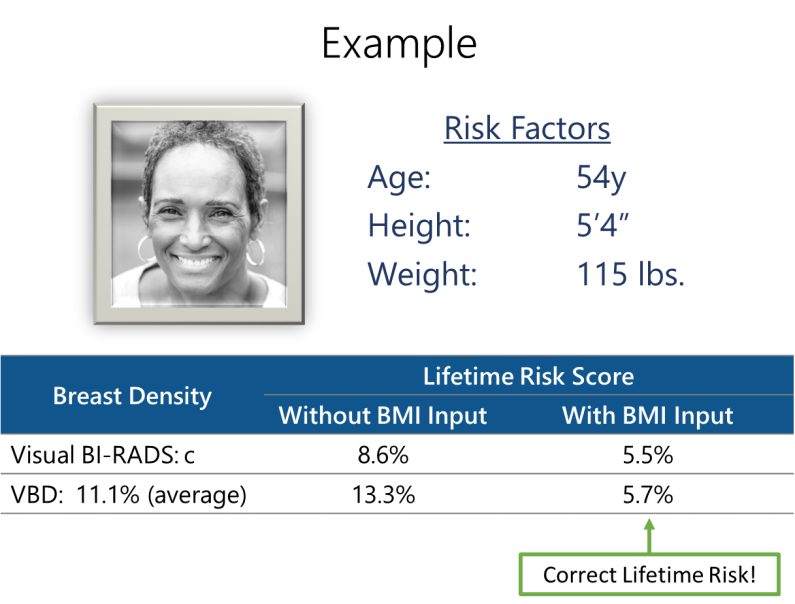Breast density is an independent risk factor associated with the development of breast cancer.1, 2, 3, 4 Adding breast density to risk calculation has been shown to more accurately predict the risk for developing breast cancer. 5, 6 However, when used in a risk model, the breast density risk calculation becomes one piece of the larger puzzle. Each risk model may calculate breast density risk differently. It is important to understand how breast density risk is calculated and applied to the overall breast cancer risk calculation.
How is breast density risk determined in the Tyrer-Cuzick risk model?
Version 8 of the IBIS Breast Cancer Risk Evaluation Tool, also known as the Tyrer-Cuzick risk model or TC8, uses residual breast density to determine breast density risk.
What is residual breast density?
A simple formula for residual density is:
Actual breast density – Predicted breast density = Residual breast density
Let’s break that apart:
1) Studies have been conducted to identify the typical density for a patient of a specific age and body mass index (BMI) and of average risk for developing breast cancer.5, 6, 7, 8 This breast density is known as predicted density.
2) Taking the difference between the predicted density and a patient’s actual density – whether visually assessed using the ACR BI-RADS®Atlas or Volpara®Density™ volumetric breast density percentage (VBD%) – determines the residual breast density risk.
3) If the residual breast density is positive, then the risk contribution due to breast density increases. Conversely, if the residual breast density is negative then the risk contribution due to breast density decreases.
In risk models like Tyrer-Cuzick where residual breast density is used in the calculation, additional factors like age, height and weight9 which were used to determine the predicted density value must be included to ensure the accuracy of the model.
Omitting this information will result in a faulty or incorrect risk assessment.
In the example below a woman’s lifetime risk score is calculated using the TC8 model with and without BMI information.
Without BMI, breast density residual risk cannot be determined because both are required to calculate this risk.
When BMI is included with BIRADS or VBD%, the residual risk can be calculated giving a realistic risk associated with breast density.

“If entering mammographic density, then it is also very important to enter height and weight to obtain the most accurate risk assessment for an individual woman.” 9 – Professor Jack Cuzick
1. Boyd, N.F., Martin, L.J., Yaffe, M.J. & Minkin, S. Mammographic density and breast cancer risk: current understanding and future prospects. Breast Cancer Res 13, 223 (2011).
2. McCormack, V.A. & dos Santos Silva, I. Breast density and parenchymal patterns as markers of breast cancer risk: a meta-analysis. Cancer Epidemiol Biomarkers Prev 15, 1159-1169 (2006).
3. Boyd, N.F., Guo, H. & Martin, L.J. Mammographic density and the risk and detection of breast cancer. N Engl J Med 356, 227 (2007).
4. Boyd, N.F. et al. Quantitative classification of mammographic densities and breast cancer risk: results from the Canadian National Breast Screening Study. J Natl Cancer Inst 87, 670-675 (1995).
5. Brentnall, A. & Cuzick, J. Risk models for breast cancer and their validation, 2019.
6. Brentnall, A.R. et al. A Case-Control Study to Add Volumetric or Clinical Mammographic Density into the Tyrer-Cuzick Breast Cancer Risk Model. Journal of Breast Imaging (2019).
7. Brentnall, A.R. et al. Mammographic density adds accuracy to both the Tyrer-Cuzick and Gail breast cancer risk models in a prospective UK screening cohort. Breast Cancer Research 17, 147 (2015).
8. Brentnall, A.R., Cuzick, J., Buist, D.S.M. & Bowles, E.J.A. Long-term Accuracy of Breast Cancer Risk Assessment Combining Classic Risk Factors and Breast Density. JAMA oncology 4, e180174 (2018).
9. Cuzick, J. IBIS Breast Cancer Risk Evaluation Tool. 2017 [cited 2020 March 15] Available from: http://www.ems-trials.org/riskevaluator/
